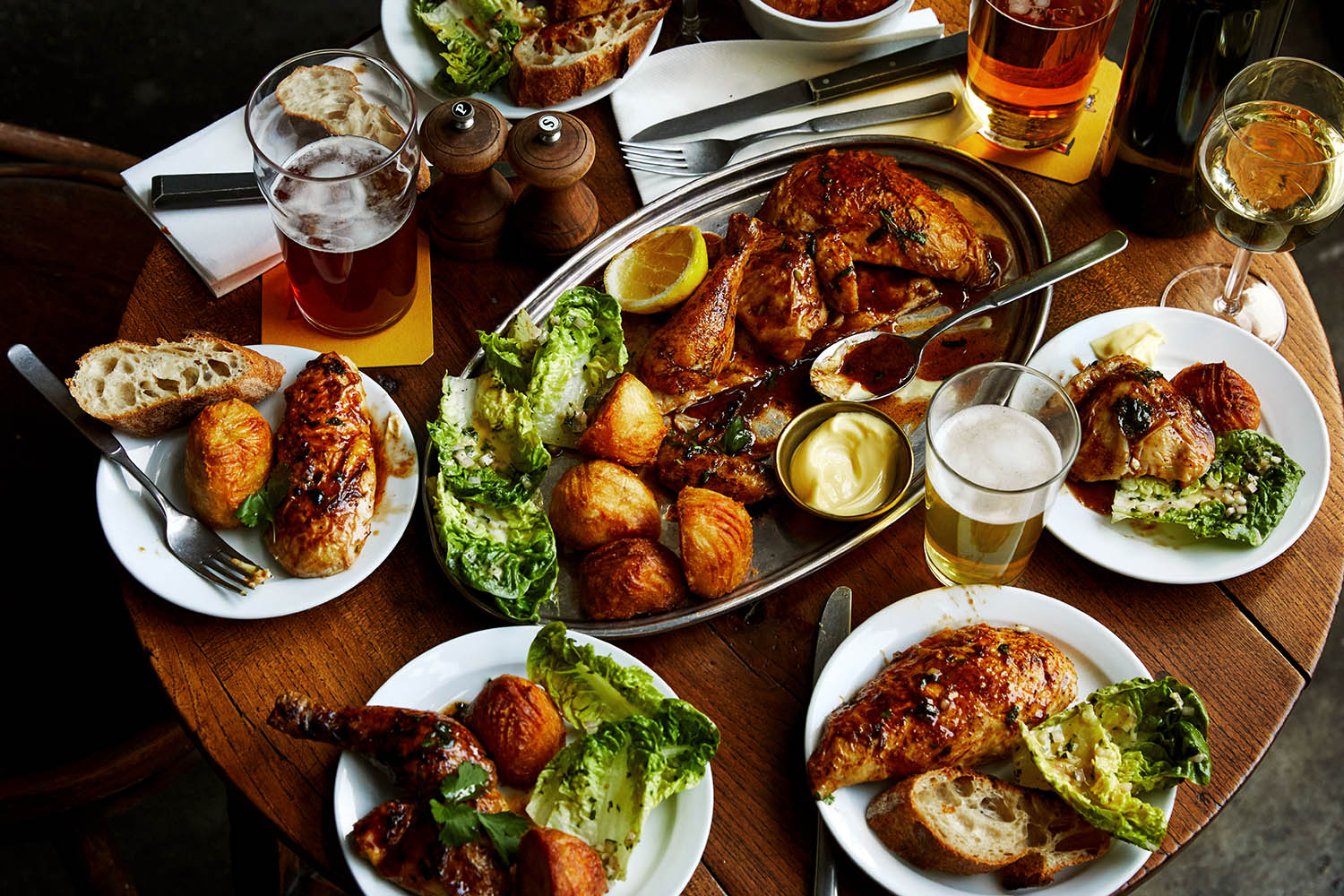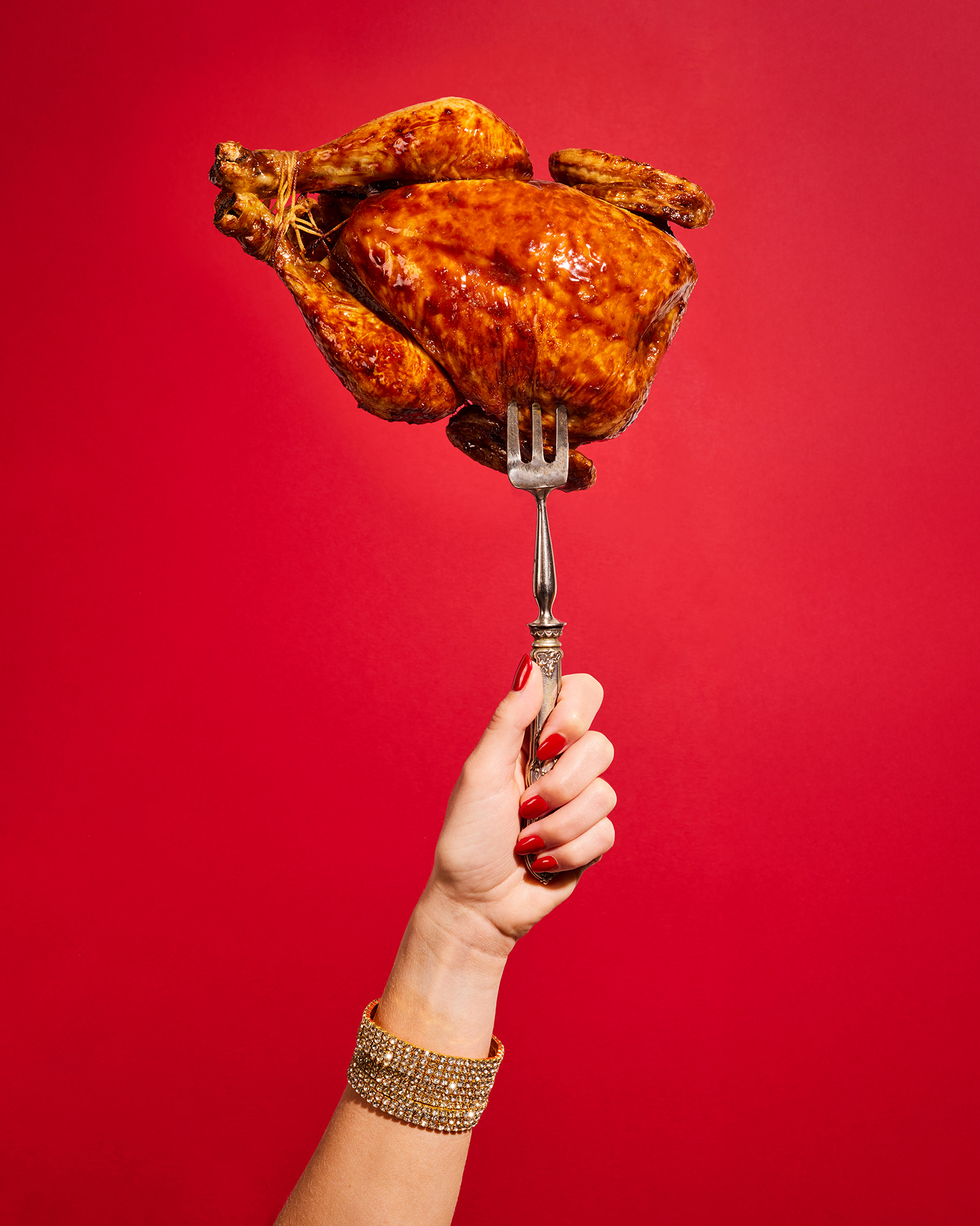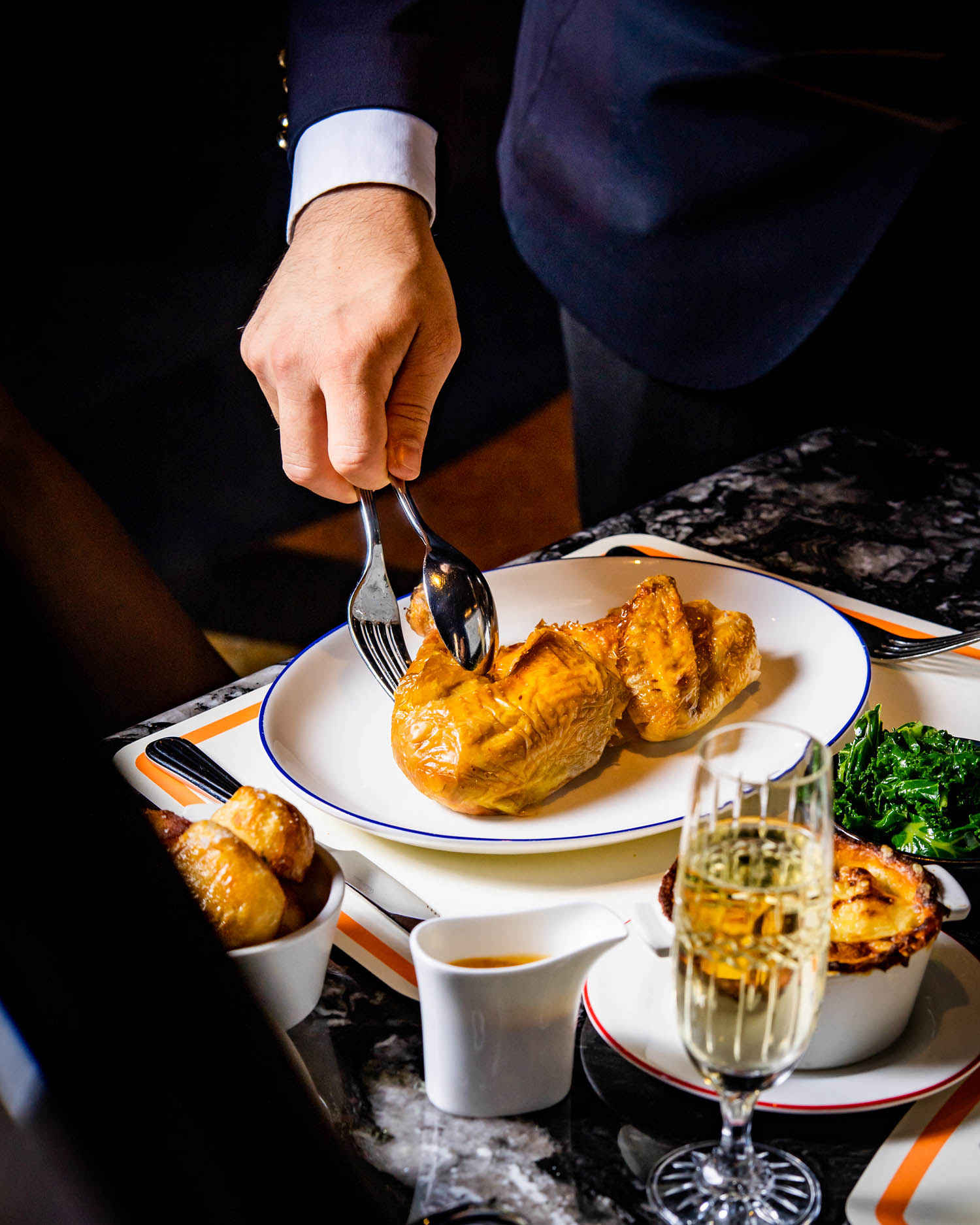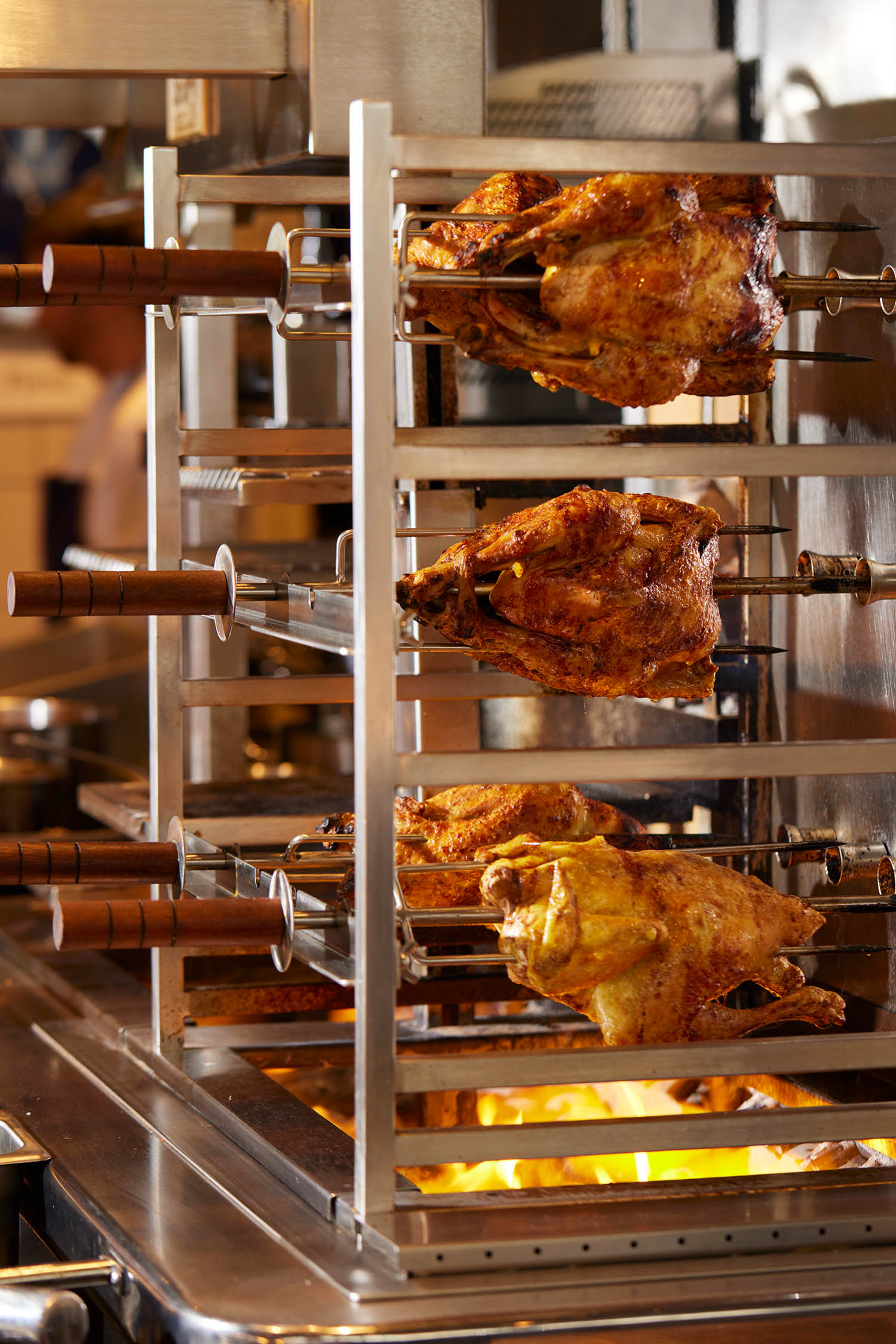Photographs by Ellis Parinder
It’s a spring evening at one of London’s most luxurious restaurants – glossy, with frosted martinis on marble tabletops, and customers doing caviar bumps. The reason we’re here? A dish that usually leaves the supermarket in a clammy, sticker-clad sack and sometimes makes it home intact.
Tonight at Bébé Bob in Soho there’s not a plastic bag in sight. Instead, it’s delivered on a monogrammed ceramic plate by a smooth, smartly dressed server, who brings with it two glasses of gavi di gavi, a cone of fragrant truffle-topped chips, and a jug of satiny jus. “Rotisserie chicken,” she beams, presenting the bronzed bird to the table as though we’re at the Royal Cornwall Show. “Enjoy!”
Nicknamed “roto”, “spinny chicken” or “the bachelor’s handbag” for the supermarket variety, the dish is the product of a method developed as early as the 12th century, which involves skewering meat on a spit and turning it slowly over a heat source to achieve an even cook. First recorded as “rotisserie” in Paris in the 1450s, they were once operated by “spit boys”, until mechanical and electric iterations were developed in the 19th and 20th centuries. Today, an estimated 1bn precooked birds are sold worldwide each year, with US retail group Costco responsible for a staggering 137m alone.
According to the chef Vivian Curcine, at Bébé Bob, one of theirs simply doesn’t compare. “This isn’t a normal rotisserie chicken,” she says, catching her breath between tickets behind the shiny, stainless-steel pass. “From the ingredients we use to the service and the decoration upstairs, it’s a completely different experience.”

Bébé Bob isn’t the only restaurant placing rotisserie chicken front and centre. Tom Sellers, the chef behind the two Michelin-starred fine dining Restaurant Story, dedicated his third London venue, Story Cellar, to giving the bird the bougie treatment. In Leeds, chef Sam Pullan has been championing roto for some time. “I did it over a fire outside in that period between lockdowns and I saw how people really went for it.” He opened the Empire Cafe in 2023 to serve birds basted in a range of signature blended butters – garlic, lemon and tarragon, chilli-spiked honey, and smoked garlic. “It’s fine dining with a comfort edge,” he says, proud that customers can pair their roast with a cocktail from award-winning mixologist Alex Holmes. “He’s like number 16 in the world, and he’s our bar manager, shaking cocktails.”
Over the past 12 months, spit-roasting poultry restaurants have continued multiplying, with three arriving in central Manchester over the past six months. On Quay Street, Tartuffe is less old-school glitz, more cheeky, sophisticated, mid-century modern charm. “The concept began because I thought it would be really funny to have a roti restaurant where the logo was a pole-dancing chicken,” says co-founder Ruby Fryman while dissecting a steaming bird, which sits on the menu alongside hash browns laden with creme fraiche and caviar.
Back in London, restaurateur John Ogier and chef Jack Coghlan, formerly of Lyle’s (a stylish fine-dining restaurant, once a fixture of the World’s 50 Best Restaurants list), want to create a sense of cheer with their new neighbourhood place, Norbert’s, which opened in East Dulwich this month. “I’m not forgetting everything I’ve learned over the past 10 years,” says Coghlan, covered in dust at the building site. “I’m just channelling it into delicious chicken. I want it to be fun and not pretentious at all.”

Across the river, at new pub Knave of Clubs in Shoreditch, chef Patrick Powell shares the sentiment. Having previously run kitchens at elevated dining destinations including Allegra, Chiltern Firehouse and the Midland Grand, he is now dedicating his time to glossy chicken with fat-roasted potatoes, salad and crusty white baguette. “I’ve spent years killing myself trying to do fancy stuff and then you think, ‘I’ll do roast chicken on a tray,’ and everyone's like, ‘This is the best dish I’ve had in years!’”
“To make really good chicken and chips is very hard at home,” says François O’Neill, co-founder of London’s Cafe François, explaining why it not only remains a favourite order, but warrants a luxe approach. “Many people don’t have deep-fat fryers, let alone rotisserie machines. Serving a whole chicken in a restaurant requires a lot of skill. Yes, it’s just chicken and potato, but a lot of elements go into that to make it very special.” And the rotisserie set-up really does make a difference, says Robert Homer, head chef at Story Cellar. “The chicken is always going to be a lot juicier because it’s constantly moving,” he explains. “The juices of the bird stay within it, whereas if you roast the chicken, it just sits there and they soak out.”
‘I’ve spent years doing fancy stuff, then you do roast chicken and everyone loves it’
As to why it’s all happening right now … “I think a better question is: ‘Why has it taken so long?’” says food influencer James Dimitri, who has started reviewing London’s rotisserie joints for the benefit of his 179,000 Instagram followers. “It could be partly down to how popular casual French dining has become over the past few years.” Florence Kickham, one half of rotisserie-focused roving pop-up Flock (most recently at Loop in east London), agrees, linking the rise with small-plate fatigue. “There’s been a renaissance of French food. I think a lot of people who’ve experienced small-plate restaurants are now realising that bistro dining is equally as convivial and enjoyable.”
Giving people what they really want certainly comes into it. “People can’t afford to go out all the time and try new things like they used to,” says Sam Grainger, who has a whole bird for £28 at Manchester’s relaxed Medlock Canteen. “When they go out, people want something they know and love, and to have a nice time.” And, hopefully, return. Powell from Knave of Clubs, who serves a whole roast chicken with sides for £38, thinks the rise of rotisserie chicken reflects how difficult it is for restaurateurs to turn a profit in the current economy. “It is very hard to run a restaurant and make money,” he says. “Your average person could come here a few times a month, whereas they couldn’t go and experience very fine dining for that.”

By relieving customers of choice of main course, and setting expectations and reassurance around cost, Powell sees customers splashing out on sides and extras, such as his prawn toast scotch egg, perhaps a martini to start. “I think perception of value is a very important thing,” he explains. “If you have something reasonably priced and people come in and they’re there and having a good time, they’re like, ‘Oh well, let’s have a few snacks.’ And, ‘This is a good atmosphere here, let’s have a few more pints. Let’s have a dessert.’ Then they leave in a good place about what they’ve spent because they’ve chosen to do so – as opposed to going somewhere that you know is going to be expensive.”
Another benefit of rotisserie and a limited menu, says Jamie Pickles, co-founder and chef at Manchester’s Trading Route (whose bird is £22), is saving on staffing costs. “We still have a big front of house team as we want to provide excellent service, and there’s a lot of preparation involved, but when it comes to actually serving the food, we don’t need a full kitchen brigade of six or seven. We only need two chefs working during service.”
For many, going out for steak has long been a treat meal, with showcase cuts (ribeye, porterhouse) to share the order of the day. But with some cuts costing north of £150 a kilogram for customers, the rising price of beef is likely another reason chefs are turning to chicken. “It’s skyrocketing,” says Nemanja Borjanović, behind Harley’s, a new butcher’s shop selling “premium” rotisserie chicken in Hampstead, London. “Most chefs are forced to use secondary cuts, but with chicken you can offer a high-quality product for less.” Moreover, according to O’Neill – whose whole rotisserie chicken comes in at £56 – the dish can create a celebratory feeling for less. “I think they really balance well with a sense of occasion. There’s a sense of theatre to sharing a chicken.”

Still, with a supermarket rotisserie chicken retailing at between £6 and £8, many restaurateurs struggle to justify the cost to customers. Dimitri, who reviews both market stalls and fancy central London operations, has witnessed many people calling foul. “When I posted the £38 rotisserie chicken at Toum, there were loads of people in the comments section calling it a rip-off and quoting how much they pay for a chicken at their local supermarket, which of course isn’t relevant at all,” he says. “This is a restaurant. They sell a quality 1.5kg chicken that has had hours of preparation.”
For Pullan, it’s frustrating. “People’s perception of what chicken should cost in this country is ridiculous. You can walk into a local supermarket and buy a whole chicken for the same price as you would pay for a latte, and that seems really wrong, doesn’t it? The quality of the chicken that we get is not cheap, we get them from Son’s Farm, based near Hull,” he says. Needless to say, provenance matters. “If you buy a basic chicken from the supermarket, you know how it tastes,” says Homer, whose whole chicken is £57. “Try one of our corn-fed, free-range chickens and you’ll think, ‘Wow, this is 10 times better!’”
The high-low contrast is part of the beauty of the bird, according to Kickham. “It can be super simple, super quick, super affordable and super easy, but can also be an exceptional, hyper-luxury dining experience,” she says. “Rotisserie, for us, is proof that something so simple can be so exceptional if it’s done right.”
Now, who’s peckish?
James Moyle. Prop styling: Ellis Parinder. Food styling: Sonali Shah. Hand model: Sophie Fryer
